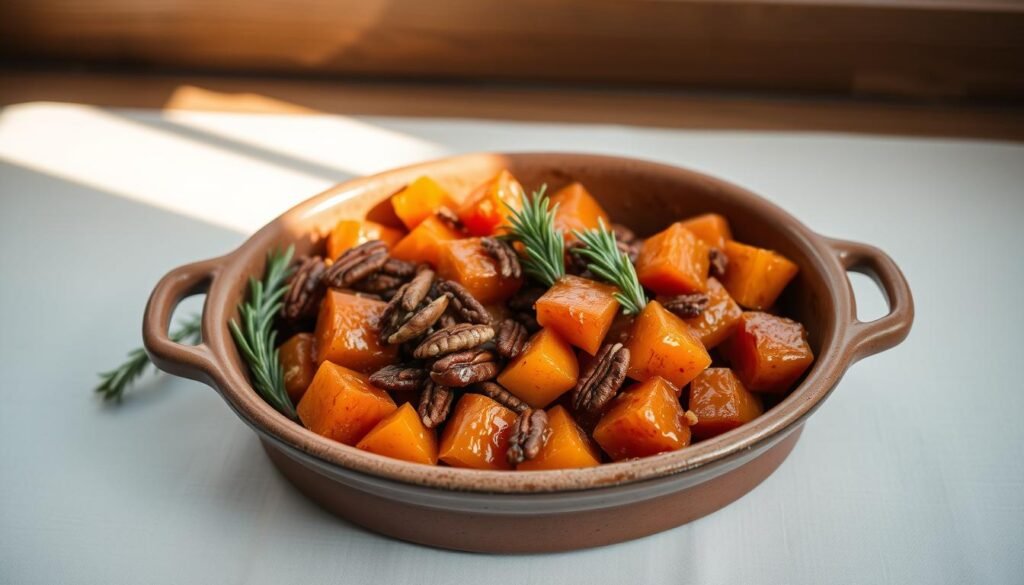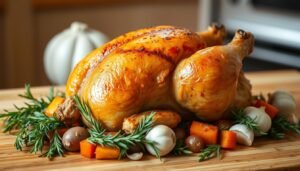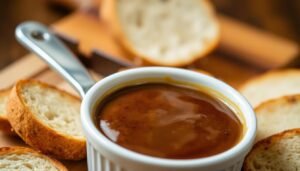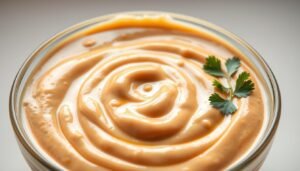Thinking about my favorite Thanksgiving dishes, candied yams always comes to mind. They’re a hit at family gatherings. And it’s easy to see why: they taste great and are simple to make.
I’m excited to share my version of this yam recipes favorite. It’s a tradition at our Thanksgiving table. With just a few ingredients and simple steps, you can wow your guests.
Key Takeaways
- Easy to prepare candied yams for your Thanksgiving gathering
- Simple ingredients are all you need to make this classic dish
- A delicious and traditional addition to your holiday menu
- Candied yams are a staple at many Thanksgiving gatherings
- A great way to impress your guests with a simple recipe
What Are Candied Yams?
Candied yams have a rich history and a unique taste. They are often confused with sweet potatoes. This dish is a key part of many holiday meals.
A Brief History of Candied Yams
Candied yams come from African and Asian traditions. They were cooked in sugar to preserve and flavor them. This tradition is loved in the Southern United States during holidays.
For more on sweet potato recipes, check out roasted sweet potatoes with special seasonings.
Differences Between Yams and Sweet Potatoes
Yams and sweet potatoes are often mixed up. But they are different. True yams are starchier and drier, from Africa and Asia. Sweet potatoes, used in “candied yams,” are sweeter and moister, from the Americas.
This mix-up started with European colonizers. They called sweet potatoes “yams.” In the U.S., what’s called a “yam” is usually a sweet potato. Knowing the difference helps in making candied yams.
Essential Ingredients for Candied Yams
The secret to tasty candied yams lies in the ingredients. I’ll show you the best picks. The quality and taste of your candied yams depend on what you choose.
Fresh Yams vs. Canned Yams
Fresh yams give a richer flavor and better texture. But, they need more prep time, like peeling and cooking. Canned yams are quicker but softer and less tasty. For a real taste, go for fresh yams. But canned yams are okay when you’re short on time.
Looking for new recipes? Check out Retro Rose’s Legendary Stovetop Candied Sweet for ideas on different ingredients and methods.
Sweeteners: Brown Sugar, Maple Syrup, and More
The sweetener you pick changes the taste of your candied yams. Brown sugar gives a deep, caramel sweetness. Maple syrup adds a rich, complex flavor. Try honey or agave syrup for a unique taste.
Think about the flavor you want. Brown sugar is classic for candied yams. But mixing sweeteners can make a tasty, unique flavor.
Preparing Your Yams
Getting your yams ready is key to making great candied yams. It ensures they cook evenly and have the perfect texture. Here, I’ll show you how to prepare your yams.
Washing and Peeling Yams
Start by washing your yams well. This gets rid of any dirt or debris. Then, peeling the yams is crucial to remove the tough skin.
- Rinse the yams under cold running water.
- Use a vegetable peeler to remove the skin.
- Pat the peeled yams dry with a clean towel.
Slicing Techniques for Even Cooking
After peeling, slice your yams. Slicing them right is key for even cooking. You want slices that are uniform in thickness for even cooking.
Here are some tips for slicing yams:
- Use a sharp knife to slice the yams.
- Cut the yams into rounds or slices, about 1/4 inch thick.
- Try to make the slices as uniform as possible.
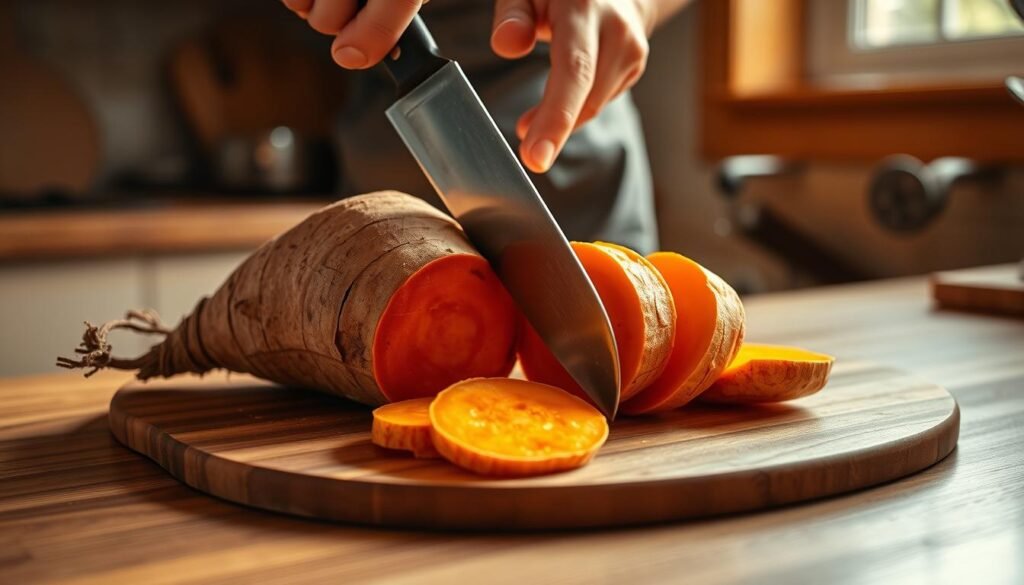
By following these steps, you’ll prepare your yams perfectly for candied yams. Well-prepared yams make your dish both tasty and beautiful.
Cooking Methods for Candied Yams
Choosing how to cook candied yams can really change the taste. You can pick from several methods, each with its own benefits. This makes it easy to find a way that fits your taste and schedule.
Traditional Baking Method
Baking candied yams in the oven is a timeless choice. It makes the outside caramelized and rich. First, heat your oven to 400°F (200°C). Cut your yams into the right thickness and put them in a dish.
Then, add your favorite syrup and spices on top. Bake for 45 minutes to an hour. Wait until the yams are soft and the top is glazed.
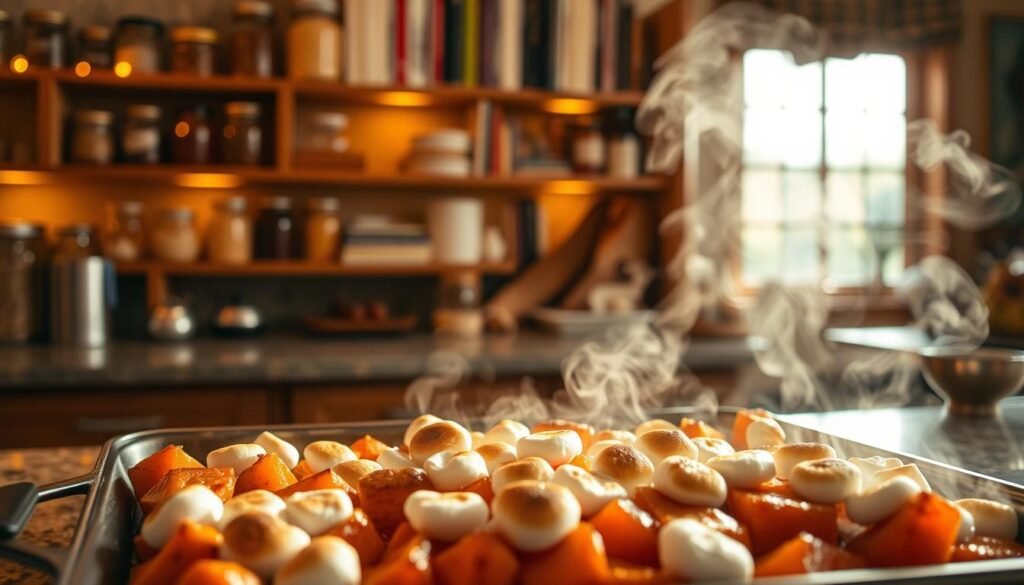
Slow Cooker Variation
Using a slow cooker is a great way to cook candied yams without much effort. Just put your sliced yams, syrup, and spices in the slow cooker. Cook on low for 4-5 hours or high for 2-3 hours.
This method makes sure your yams are tender and full of flavor. You don’t have to watch them all the time.
Stovetop Preparation
Cooking candied yams on the stovetop is quick and easy. In a big skillet, mix your sliced yams, syrup, and spices. Cook over medium heat, stirring now and then, until the yams are soft and the syrup thickens. This usually takes 20-25 minutes.
| Cooking Method | Cooking Time | Advantages |
|---|---|---|
| Baking | 45 minutes – 1 hour | Rich, caramelized exterior |
| Slow Cooker | 4-5 hours (low), 2-3 hours (high) | Hands-off, tender yams |
| Stovetop | 20-25 minutes | Quick, nice glaze |
Each method has its own way of making candied yams. You can pick the one that suits you best. Whether you want a traditional baked dish, a slow-cooked meal, or a quick stovetop recipe, you can make delicious candied yams.
Flavor Enhancements for Candied Yams
Adding extra flavors to candied yams makes them truly special. The secret is in the subtle yet impactful additions you make. These can turn a good dish into a great one.
Spices are a simple way to boost flavor. Cinnamon and nutmeg are perfect for yams. They add depth and a cozy aroma to your kitchen.
Adding Spices: Cinnamon and Nutmeg
The quality of spices like cinnamon and nutmeg matters. Freshly grated nutmeg tastes better than pre-ground. High-quality cinnamon sticks or ground cinnamon also make a difference.
To add these spices, sprinkle them over the yams before baking. Or mix them into the syrup for extra flavor. Start with a small amount—about 1/4 teaspoon of cinnamon and a pinch of nutmeg—and adjust as needed.
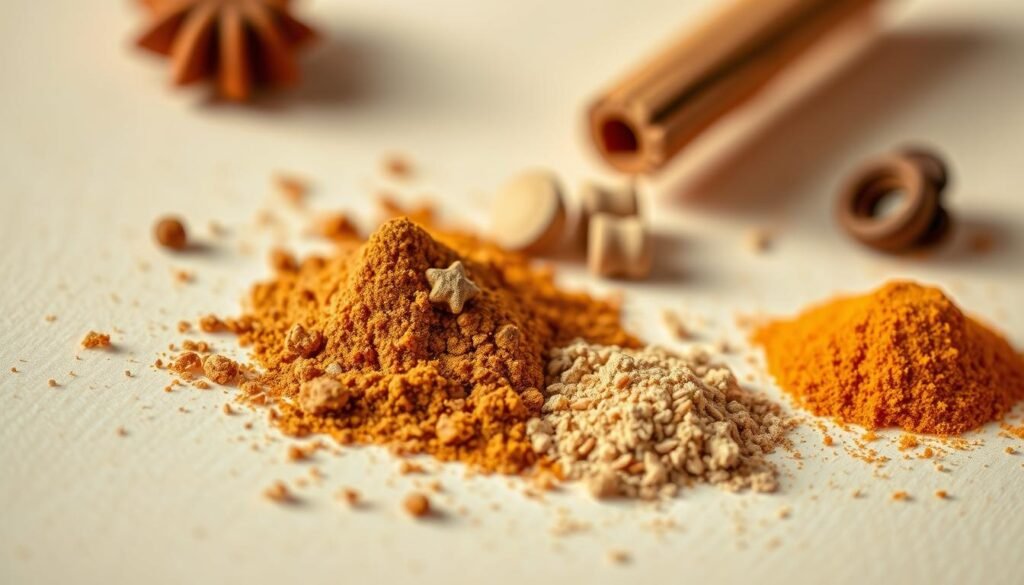
The Role of Vanilla Extract
Vanilla extract is also key for flavor. A few drops of high-quality vanilla can add a creamy, sweet flavor. It complements the yams well.
Vanilla extract balances the flavors. It adds a subtle complexity. This ties together the sweetness of the yams, the syrup’s richness, and the spices’ warmth. Start with a small amount and taste as you go.
With these flavor enhancements, your candied yams will be delicious and memorable. They’re perfect for holiday gatherings or family dinners. These additions will surely impress.
Creating the Perfect Syrup
The secret to amazing candied yams is in the syrup. A great syrup can turn a good dish into an outstanding one. It’s also a chance to get creative with flavors, making it key to your recipe.
Brown Sugar and Butter Combination
The classic syrup mix is brown sugar and butter. This combo makes a sweet, caramel-like sauce that goes well with yams. For the best taste, use brown sugar and unsalted butter of high quality.
Here’s a simple recipe to start:
| Ingredient | Quantity |
|---|---|
| Brown Sugar | 1 cup |
| Unsalted Butter | 1/2 cup |
Mix the brown sugar and butter in a saucepan over medium heat. Stir until the sugar melts. Then, simmer for about 5 minutes until it thickens a bit. This syrup is tasty and simple to make.
Alternatives for a Richer Flavor
Want to try something different? You can use maple syrup or honey for a unique flavor. These sweeteners can make your candied yams even better.
For a richer taste, add a bit of bourbon or vanilla extract to your syrup. These can add complexity and depth, making your dish special.
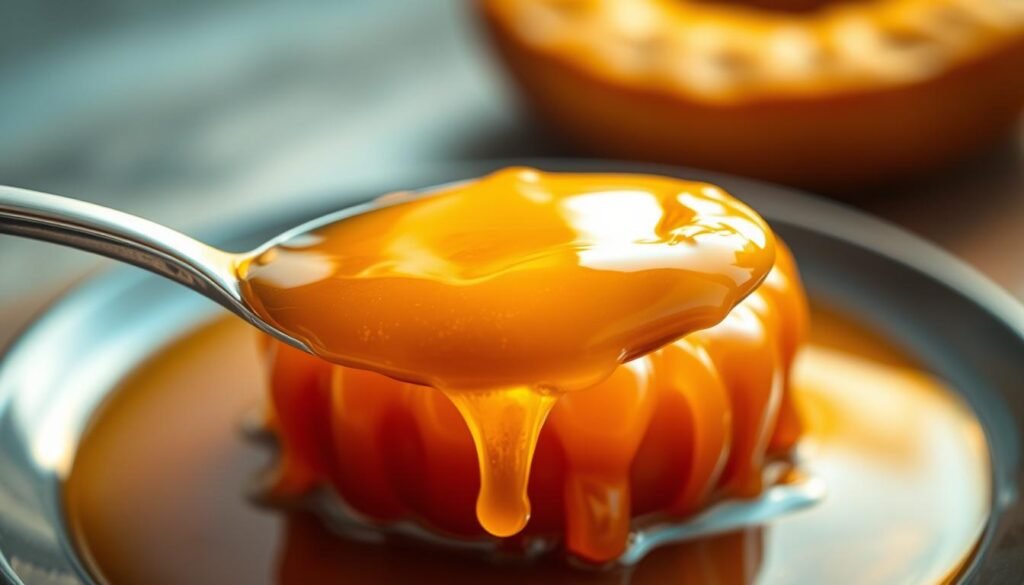
Tips for Making Candied Yams Ahead of Time
Preparing candied yams ahead of time can make your Thanksgiving dinner less stressful. With a few simple steps, you can enjoy your candied yams without the last-minute rush.
Refrigeration and Storage Techniques
Let candied yams cool completely before refrigerating them. This prevents moisture buildup and keeps them from getting soggy. Store them in an airtight container or cover them tightly with plastic wrap or aluminum foil.
It’s important to keep candied yams away from strong-smelling foods. They can easily absorb odors. You can store them in the fridge for up to 3 days.
| Storage Method | Duration | Tips |
|---|---|---|
| Airtight Container | Up to 3 days | Keep away from strong-smelling foods |
| Plastic Wrap or Aluminum Foil | Up to 3 days | Ensure tight coverage to prevent drying out |
Reheating Your Candied Yams
Reheating candied yams is easy. You can use the oven or microwave. For oven reheating, cover the yams with foil and heat at 350°F (175°C) for 20-25 minutes, until hot.
For microwave reheating, place the candied yams in a microwave-safe dish. Cover them with a microwave-safe lid or plastic wrap. Heat on high for 2-3 minutes, until hot and steaming.
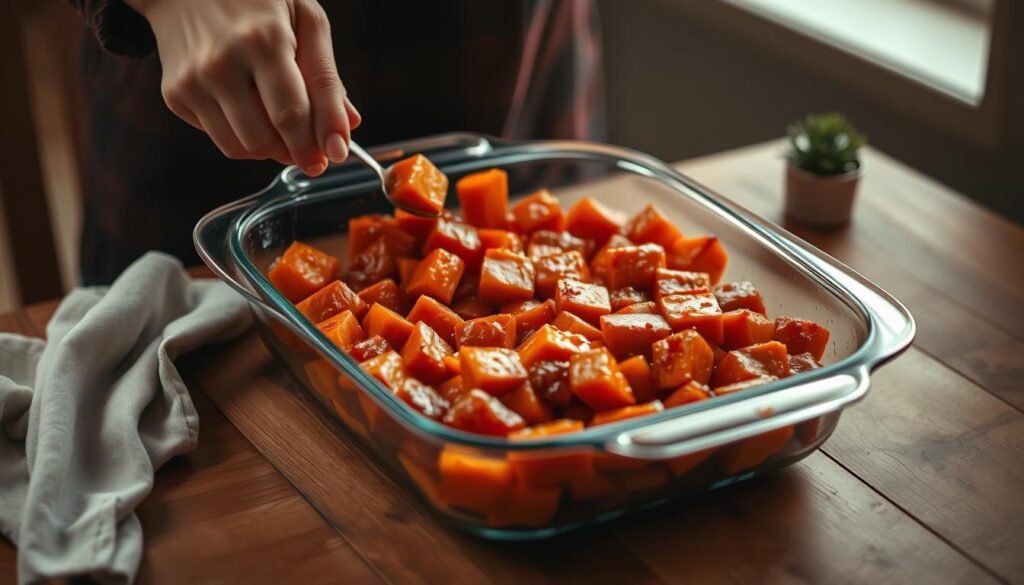
By following these tips, you can enjoy your candied yams at their best, even when made ahead of time.
Serving Suggestions for Candied Yams
To make your candied yams shine at Thanksgiving, consider these serving suggestions. Candied yams are a beloved side dish. They pair well with many traditional Thanksgiving foods, making your meal memorable.
Pairing with Traditional Thanksgiving Dishes
Pairing candied yams with other Thanksgiving classics can enhance your dining experience. Serve them with roasted turkey, green beans, or mashed sweet potatoes. The sweetness of the candied yams complements the savory flavors, creating a balanced taste.
For a modern twist, pair candied yams with seasonal ingredients like Brussels sprouts or caramelized onions. This adds complexity to your traditional Thanksgiving menu.
Garnishing Ideas for Presentation
Garnishing your candied yams can make them a standout on your Thanksgiving table. Add a sprinkle of cinnamon or nutmeg for a warm, inviting look. Use fresh herbs like thyme or rosemary to add color and freshness.
For a luxurious touch, top your candied yams with maple syrup or toasted pecans. This adds a special touch that will impress your guests.
By thoughtfully pairing and garnishing your candied yams, you can create a special Thanksgiving experience for your family and friends.
Common Mistakes to Avoid
Making candied yams can be tricky. Knowing the common mistakes can help you make a tasty side dish for Thanksgiving.
Let’s look at some common errors people make. By avoiding these, you can make sure your candied yams are perfect.
Overcooking Yams for Perfect Texture
One big mistake is overcooking the yams. Yams should be tender but still firm. Overcooking makes them mushy. To avoid this, check your yams often while they bake.
Here’s a simple guide for the perfect texture:
| Cooking Method | Checking Time | Desired Texture |
|---|---|---|
| Baking | Every 10 minutes after 30 minutes | Tender, slightly firm |
| Slow Cooker | Every 30 minutes after 2 hours | Tender, not mushy |
| Stovetop | Constantly after initial simmer | Tender, slightly caramelized |
Balancing Sweetness: Avoiding Sugar Overload
Another mistake is adding too much sugar. Candied yams are sweet, but too much sugar can be overwhelming. Use the right type of yams and adjust the sugar to balance it out. You can also try maple syrup for a different sweetness.
Here’s a comparison of sweeteners and their sugar content:
| Sweetener | Sugar Content per Tablespoon |
|---|---|
| Brown Sugar | 12-15 grams |
| Maple Syrup | 8-10 grams |
| Honey | 6-8 grams |
By avoiding these mistakes, you can make a delicious dish for Thanksgiving.
Variations on the Classic Recipe
The classic candied yams recipe is a Thanksgiving favorite. But, there’s always room for new flavors. Try adding different ingredients for exciting tastes.
Nutty Flavors with Pecans
Adding nuts like pecans can make candied yams crunchy and nutty. Just sprinkle toasted pecans over the yams for the last 10 minutes of baking. This is a tasty twist on candied yams.
Fruity Twists with Dried Fruit and Cranberries
Adding dried fruit or cranberries can make candied yams sweeter and tangier. These fruity additions can make the dish unique. It’s a great way to change up the classic recipe.
Don’t be afraid to try new combinations. You can make your own special candied yams recipe. These variations let you put your own spin on this beloved dish.

